The Smiling Rock – A conversation with Lindsay Lawson
Thu 17 Aug 2017For this year’s festival you will be showing the actual rock from The Smiling Rock project, is that right?
LL: Yes that’s correct and there will be an installation that the rock itself is set within. I’ve made a bunch of different types of work that have incorporated the actual rock. A film I’ve been working on for years now is about a fictional version of [the rock] and I’ve made sculptural and photographic exhibitions about it too, but the main thing I am tapping into for AND festival is about a text I wrote that is describing what actually happened with the guy who owns the rock and is trying to sell it on eBay. The text documents what has happened during The Smiling Rock project. I first wrote it to accompany showing the rock but the text has grown over time as other things have happened. The text is always growing with sections added onto the end. It’s been shown as a video, a slideshow and as a performative lecture, but considering it is such a unique location I’m making an installation this time. I’m interested to change it because up until this point each viewing of the work has been pretty didactic thus far and the idea of a lecture performance text.
You started The Smiling Rock around 2012, is that right?
It’s hard to say the exact point when the project started, it began when I found it on eBay. I finally decided to write a short fictionalised point of view of the buyer that had an affinity for the rock which became a jumping off point for many works. At the end of 2012, I had a solo exhibition about the film that I was starting to write. It was about a woman who was falling in love with this stone that she had “met” online. The film is asking if a rock could have an online presence, specifically a kind of a dating presence. The exhibition consisted of sculptures and digital renders shown as photographic works. It was a show about a film that I hadn’t even finished writing at the time so in terms of timeline it was jumping around a bit and was about things I had yet to do as much as things that I had done, or don’t exist, or are fictional or a documentary.
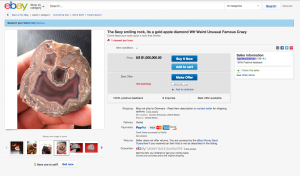
It is interesting that you describe the works that have come out of this project as being didactic. I saw a trailer for the film you are talking about and I thought it was very speculative in its approach. You’ve referred to ‘objectum sexual’ a few times when talking about the project. Could you tell me a bit about that term and how you think desire plays out in this piece in particular?
It all started when I wrote this one page story that was about the sexualized desire for owning a thing you could win on eBay. I was playing with the desire to own an aesthetic or collectable thing. People talk about ‘things’ being sexy that they don’t find sexual but there is a lust for the thing. The reason I made that twist at all was because of the seller – the real seller himself – whose username is Guitarpickman.com. He often chose to change the title of the eBay listing over the years, he’s still doing it, and one day he changed it to something that was very sexualised. He wrote something like “one of a kind sexy rock” in the listing. I figured it was just a way to get more clicks because you’ll see people sexualise search terms for all kinds of things, like vintage photos for example. Sexualising certain items might get an eBay listing more page visits and perhaps Guitarpickman just thinks it’s funny but that was the original inspiration to make the work turn in that direction.
My awareness of Objectum Sexual (OS) came after I wrote this piece and stumbled upon some OS related articles online. I ended up researching a lot about it and meeting this woman, Erika Eiffel, an OS person who has really made it her life’s mission to raise awareness about this sexuality. She happens to live in Berlin, so I’ve met her a number of times and we’ve done a project and some talks together. This idea of desire came out of this kind of weird strangeness of this actual eBay listing. I became interested in it as a way to look at people’s relationships to objects. It doesn’t have to be someone who is in love with a thing, but it can be about a parallel way that people talk about an object they love, or someone who is creating an aesthetic object. It is about the meaning of an object – its history, its context, and it is all of these things together. In that way OS became really fruitful for a lot of other projects I have made, beginning with that idea and then departing to think more broadly about how objects have agency that is somehow untapped or brought about through a community. My interest is in how objects have agency via people, even if this is an untapped agency. I’ve made a lot of work about that, about fictional desire. My fictionalised character having desire for this one object online, which parallels my own experience with the smiling rock, I’ve thought about it, made so much work about it but I’ve never really seen it in person. Doing this show for AND I’ll see the rock for the first time ever. I’m going to do it but I’m kinda freaking out about it.
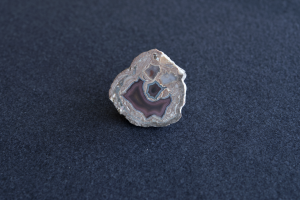
It reminds me of religion, especially in the past when people dedicated their lives to something that they never saw like Jerusalem with the Crusades, for instance. I see desire in your work as infatuation that becomes a type of material ownership.
I’m really interested in virtual collections. For me using the Watch List on eBay is a digital collection of the things I wanted to buy but were too expensive. That was the reason I started documenting what was happening with the rock. I realised that if David Melton, the Guitarpickman, sold the rock it would disappear from eBay, it wouldn’t be in my Watch List anymore, and all the changes that happen in the listing would disappear of course. There is no archive of it so I have been archiving it myself. For me, that was a big part of it almost out of necessity somehow.
Somehow you’ve kept it alive…
It has been really fruitful to never see [the rock]. What I will do for this festival will be very specific as it has to relate to that. Thus far, I’ve avoided meeting [David Melton] in person, or even hearing his voice. It is important to keep my distance so I have a space for my imagination to interpret this situation. I’m inventing and owning it at the same time.
You have projected so much meaning onto the rock, do you think there will be a moment of disappointment when you meet it?
That’s how the film goes! The character is in love with the rock and finally gets the rock but – and it’s supposed to be a little vague – but you can sense that she is disappointed. She has spent so much money to get this rock and actually it is about the virtual version of it, you know? It lives online. The actual rock has a voice via the seller. If I owned it I would have a rock in my house that was just sitting there, it is really different.
I have wondered what the rock is like when it is sitting in David Melton’s house. He animates it by saying things in his eBay listing like, “where it is at in his house no one can see it.” He has given agency to it and it has the desire to be seen. I always imagine the rock as a tragic clown that has a smile frozen on its face. It wants to be seen but it lives in the middle of Arkansas and it belongs to a guy that has never left the states and luckily he’s into the internet and started sharing it that way. The rock is like the tragic performer. It is a classic Hollywood story about the broken actor that inside wants everyone to love them. That is the feeling I get about it based on what David has put out there how he has animated it.
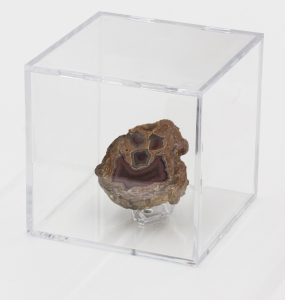
Materiality is something that you’ve made reference to, particular the philosophical movement Object Oriented Ontology (OOO)…
OOO definitely plays into it somehow, but I’m interested in how objects have untapped agency via and through people. Erika Eiffel, the women who married the Eiffel Tower and before that was in love with the Berlin wall, feels the object is misplaced in the world. Her feelings about the wall aren’t about the politics or the wall as a symbol of strength and separation, as an OS person who is misplaced in a world amongst people who are in love with each other she felt an affinity with the wall. The way she puts it it is almost like people being in love with each other is an incestuous thing. I love this idea that she feels like the wall didn’t choose the life that it has or had or what parts are still left up. She realised that she loved it when she saw it being torn down on TV and that people were attacking it and she just felt bad for this object that didn’t do anything. That connection to OOO is what I find interesting, an object having untapped agency that finds that agency by being played out through a community of people. A lot of my work has been a positive look at people having an affinity about things but the next couple of solo shows I have coming out are looking at the negative side of the meaning of objects.
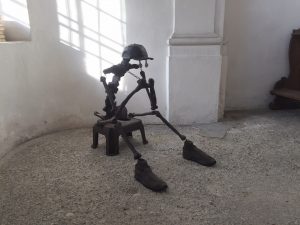
Tell me about these new solo exhibitions…
The first one is about sinks and bathrooms and about objects that have pipes connected to them and this idea of going down the drain. Particularly, how these things have a relationship with cleanliness and garbage, but also that the phrase ‘going down the drain’ is such a cliched metaphor. I started looking at these spaces, historically and specifically, as spaces of partition for minorities. Segregation in the US meant that what bathrooms and water fountains you used depended on the colour of your skin. If you look at historic photos of bathroom and sinks it does recall this time in the US, so I’m thinking about those types of objects and how they are used as oppressive spaces/objects. There is a lingering sadness about how I look at these things in the show, how I view them as wet and soggy and of course there is the object itself and how it is being implicated by things.
I’ve thought a lot about this news story about a racist sink. You know you have these sensors for the sink and the soap dispenser. The sensor reads that your hand is near and that means you don’t have to touch anything. According to this viral video there was a certain model installed in a hotel in the states and a black man went to wash his hands and the sensors couldn’t read his hands. He tried a bunch of them and they didn’t work but when his friend, a white man, tried it worked every time for him. Apparently they laughed about it and made a video and put in online, but the video began this huge discussion about looking at the way that technology is designed. Obviously the sink is not choosing who it serves but somehow it appears that way because it turns on or it doesn’t, mimicking the act of choosing. The sink seems to have been given the agency to make racist choices, but the sensor and sink were obviously made and tested by white people so it wasn’t designed for darker skin tones. That was very interesting example for me, to think about the weird, complex agency of the object that serves you or appears to refuse that service.
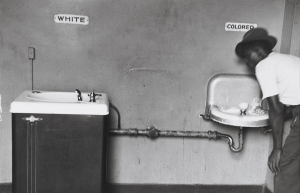
How bias is built into design, whether it is algorithms or kodak, always makes me think about where something begins and where it ends.
The other show is about chairs and Rodin’s The Thinker. This show is conflating The Thinker with the parable of Plato’s cave where the prisoner is forced to sit there and contemplate the shadows. He is eventually freed and goes up to see the light where he is essentially enlightened and understands what the reality of the world is. He goes back down and is unable to convey what he has seen. The story ends there so we don’t really know what happens next. I was thinking a lot about agency and the idea of being ‘woke’, which started as a term in black activism about knowing more – in a political dimension – about what is happening in your community, to know more about something than what might appear on the surface. Then there were a bunch of memes riffing on the you have been ‘woke’ idea, but in relation to conspiracy theories. I was interested in the idea of a poet (not just a thinker) as being able to solve the problems of the world but also as an image of inactivity. In this context The Thinker is an inactive person, maybe he is a liberal (!), and conflating this enlightened cave dweller using the chair as both a symbol of inactivity and a symbol of intellectualism. I wanted to play with the idea of this famous sculpture, in terms of its pop rather than art historical context. The Thinker exists more as an idea than an artwork: everyone knows the idea of the sculpture, but far fewer have actually seen it.
Agency and activism are collective, communal endeavours. Neuroscientists have found that when you are sat doing nothing, sort of semi-zoning out, this is one of the most active times in terms of brain activity. It is called the Deep Mode Network. I like the idea that when you look externally inactive on another, more internal level, you are at your most active.
There is a funny anecdote by the comedian Louis CK where he talks about his good intentions but without doing them because he is a shitty guy but simultaneously a good guy. One of his bits is about how he is on a plane (he flies first class a lot) and he sees a soldier get on the plane and thinks that would be so cool to give him the first class seat. Louis CK explains that he felt like a good a person just because he had that thought even though he never actually did it. The soldier never knew how about this virtual good deed. I like to think about it in those terms.
Shall we end on a Louis CK bit?
Yes!
Thanks, see you in September!
https://www.youtube.com/watch?v=grjMbV64q60
Recent Journals
- Introducing Commons // Keiken and Jazmin Morris
- Introducing our Creative Associates programme
- Reflections on the Associate Board Member Programme
- The Future of Arts Governance
- Rendering our virtual, net and digital discourses
- Announcing a new partnership between AND and the School of Digital Arts
- Impossible Perspectives 2024
- AND’s new Board Members and Associate Board Members
- Introducing AND’s new Directors
Other Journals
-
2025
-
2024
-
2023
-
2022
-
2021
-
2020
-
2019
-
2018
-
2017
-
2016
-
2015
-
2014
-
2013
-
2012
-
2011



